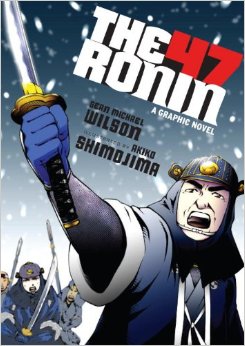Disclaimer: All of the comics reviewed in this column were either comped by the respective creators/companies, or purchased from Dr. Volts Comics in Salt Lake City.

BIFF! BANG!! POW … WOW!!!
By Jerk-Bot
47 RONIN (five-issue miniseries, full color, 144 pages, Dark Horse Comics, $3.99 per issue)
WHO’S RESPONSIBLE? Mike Richardson (writer), Stan Sakai (artist and letterer), Lovern Kindzierski (colorist), Kazuo Koike (editorial consultant).
THE 47 RONIN: A GRAPHIC NOVEL (graphic novel, black and white, 160 pages, Shambhala Publications, $14.99)
WHO’S RESPONSIBLE? Sean Michael Wilson (writer), Akiko Shimojima (artist).
Timing, as they say, is everything. How else do you explain two very different but somewhat high-profile, comics-related projects that both bear the title “47 Ronin” being released in a year in which Hollywood has produced a big-budgeted, fantasy/action-adventure movie that’s billing itself as “47 Ronin?”
That Christmas-time film release appears to have little to do with the original Japanese folk tales and legends that have inspired many other books, television programs and movies in its home country – aside from its shared title. (The somewhat race-blind casting of Keanu Reeves in a central role is one of several departures from the film and the more-faithful adaptations of this beloved revenge tale, which is held in high standing for its themes of loyalty and honor.
As for the two comics projects, they’re considerably more faithful to the source material, both in terms of tone and story. The simply titled “47 Ronin” is a long-in-development, full-color adaptation that teams Dark Horse Comics publisher Mike Richardson (as writer) and “Usagi Yojimbo” creator Stan Sakai (as the artist and letterer).
In their version, the faithful retainers and vassals of a Japanese lord, Asano, plot their revenge against Kira, a wealthy, well-connected lord who goaded Asano into an assault. (The shogunate, while sympathetic to Asano’s plight, ordered the beloved lord to commit seppuku, or suicide, and for his lands and holdings to be dispersed.)
Asano’s right-hand man, Oishi, bides his time and bids his fellow Ronin to do the same – to take their time and make sure the revenge against Kira is both fitting and honorable.
The “graphic novel” versions teams Scottish-born writer Sean Michael Wilson and Japanese comics artist Akiko Shimojima and tells a similar version of events, albeit in a black-and-white manga style.
THE GOOD.
You can tell there was a great day of research done by the creators of both projects into the costuming, the setting and language of the time period. Both sets of creators are to be commended for that, and for staying so true to the story. (Kazuo Koike, the creator of “Lone Wolf and Cub” and other Japanese comics classics, also consulted with Richardson on the story and content.)
Art wise, the Dark Horse project is much, much stronger. And it’s not just because Sakai is a more-experienced illustrator, both in terms of comics action and the samurai milieu. Relative newcomer Shimojima appears to have taken some cues from Sakai (such as the image of a spirit leaving the body of a deceased swordsman, done in a style Sakai uses in his incredible “Usagi Yojimbo” comics), though the look of her characters is cartoonish in a different way, akin to more traditional manga rather than Sakai’s sometimes exaggerated characterizations.
Speaking of which, Sakai does tone that down, through the use of more-subtle body and facial language. His flow of action and dynamism is as good as ever, and he’s aided by ace colorist Lovern Kindzierski, who paints his images in a muted, watercolor-like palate.
THE BAD.
Both books are paced very deliberately, which may come off as a bit slow. Richardson and Sakai’s version dispenses with the court intrigue by the second issue, and gets into the meatier revenge plotting much more quickly. Wilson seems almost obsessed with depicting what it was like to be in a Japanese royal court, and rushes headlong into the revenge sequences eventually (possibly too late).
Also, some readers may have a hard time differentiating Shimojima’s male characters, which are too similar in appearance. Contrast that with Sakai’s more original character designs (he’s become a master at this, even though he’s more known for drawing “funny animal” characters than for drawing human ones).
THE UGLY.
Um … anyone else notice how much the logo on the Shambhala book looks like the ones for both Frank Miller’s “300” and “Sin City?”
And Shimojima’s depictions of the suicides, killings and decapitations get a little too graphic, right down to the unconvincing, almost laughable blood spurts. By comparison, Sakai would rather imply instead of show the more sordid bits, though he’s accomplished enough to make it clear what’s happening to these characters.
IN CONCLUSION.
It’s unfortunate that Wilson and Shimojima’s book appeared so closely on the heels of the considerable better-done Richardson/Sakai one. It’s doomed to fail by comparison, though it does have a few appeals — mainly that it’s in a more-convenient, complete form months before the Dark Horse one is collected in hardcover.
And speaking of which, early issues of the Dark Horse comic are a little scarce. So you’re encouraged to pre-order the collected hardcover ($19.99), which is due in comics stores Feb. 19 next year. (This collection also promises to have production notes and pages showing Sakai’s character designs, so even if you got the individual issues, you may want to seek it out.)
Jerk-bot, better known in human form as Jeff Michael Vice, can be heard reviewing films, television programs, comics, books, music and other things as part of The Geek Show Podcast (www.thegeekshowpodcast.com), as well as be seen reviewing films as part of Xfinity’s Big Movie Mouth-Off (www.facebook.com/BigMovieMouthOff)